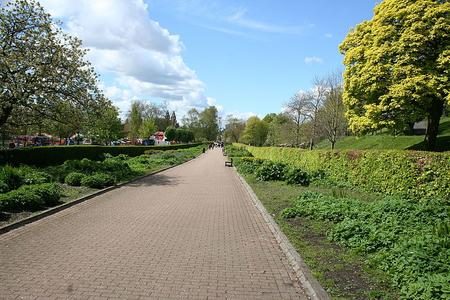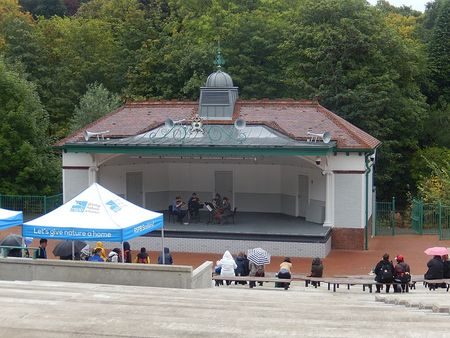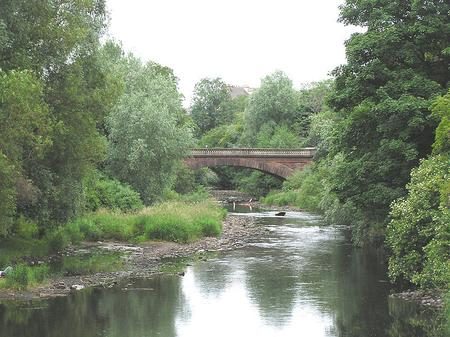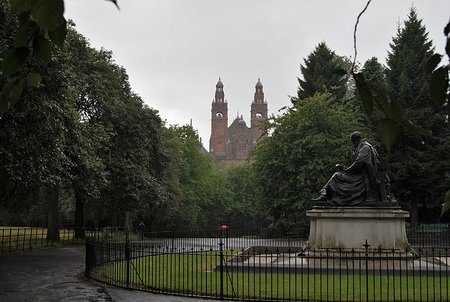In a way Kelvingrove Park is the soul of Glasgow…there are so many cultural references to it. The poet Lyle composed a song about the Park and Queensland based famous botanist Joseph Bancroft was so impressed with the park that he named his Brisbane property after it. The park has many mentions in umpteen old and new novels and the founders of the Scottish Football Club Rangers used it as their meeting ground.
The Kelvingrove park won a Green Flag in 2012 i.e. it became the benchmark national standard for green paces and quality parks. The beautiful park spreads over 34 acres and straddles the River Kelvin just before it meets with Clyde….the setting is around the edges of a large hill. Bird watchers frequent the park for it has a nice population of grey herons, goosander, cormorant, kingfisher and mallards. Common wildlife species like foxes, brown rats etc. have made this park their home.

Gilmorehill and the Glasgow University flank the park on its eastern side while Partick and Anderston flank the park to the South and Woodlands flanks the park on the north. Walkers and tourists can travel rapidly from Glasgow West end to Charing park enjoying a relaxing nature walk through the park and avoiding the traffic.
History
The park was originally named West End Park after its creation in 1852 and its original intention was the expansion of the city premises towards the western side. Sir Joseph Praxton, a reputed English gardener at Chatsworth House who happened to design the Crystal Palace worked in this garden. The land which had till then been a part of Kelvingrove and Woodland Estates was brought by the Town Council for a sum of 99,569 pounds.
The park was designed in the Victorian style and hosted 3 important exhibitions right afterwards…the International Exhibitions (1888 and 1901) and Scottish National Exhibition (1911). Many of the park’s different sections fell into disrepair at different points in time but they were all restored and the Park now possesses world-class bowling greens, a vibrant amphitheatre, Glasgow’s best museum and tennis courts besides other monuments and attractions.
What to See & Do
The Kelvingrove Park is currently the city’s most preferred area for hosting events, walks, and sports meets, political rallies, music festivals and other cultural shows. This is because the park has such a variety of spaces ranging from conference rooms to an open amphitheatre to lovely green gardens to open fields to tennis courts and bowling greens besides cafes and seating areas. It’s highly probable that some or the other event will be going on in the park when you visit it. Some high impact events that have happened here are the Glasgow Pride Walk, Glasgow Mela, etc.
Kelvingrove Art Gallery & Museum
A separate attraction in itself…exploring the art gallery with its 22 different sections and a vast array of interactive exhibits, will take up the larger part of a day. This is undoubtedly one of Glasgow’s favourite attractions and like other facets of the park is completely free to use.
Read Kelvingrove Art Gallery and Museum for details.
Kelvingrove Bandstand
The Kelvingrove Bandstand and Amphitheatre was designed by James Miller and built in 1924 and is the only original bandstand surviving in Glasgow. The bandstand stands at the city west end inside the Kelvingrove Park where its neighbours are the Glasgow University and the Kelvingrove art gallery and museum. Military band performances, music hall acts, rock concerts, rap battles, steel band festivals and charity fundraising concerts were a regular feature here.
Like other public constructs in Glasgow, the Kelvingrove Bandstand suffered many years of neglect and then closed in 1999 after repeated acts of vandalism before the Friends of Kelvingrove Park Association actively campaigned to restore and save the Bandstand. The Glasgow Building Preservation Trust restored the Bandstand in 2012 through a 2-year collaborative venture with funders and architects. The Bandstand opened in time for the 2014 Commonwealth Games opening festival and the 2014 edition of Glasgow Mela.

Post the renovation, the park had new light fixtures, improved seating, and platform lift and enhanced accessibility. Right now this is one of the best music venues of the city and is run by Glasgow life…frequent summer festivals, community meets and live music events are held here. You can check the event list on their Official Website. If you happen to visit the bandstand on Wednesdays then you can see locals performing in a new community venture called ‘Open Wednesdays’.
5 Bowling Greens
Back in 1595 bowling was banned in the Sabbath in Glasgow but by 1804 the ‘Society of Bowlers’ was formed in the city and the sport was hugely popular by 1990 when there were more than 100 bowling clubs in the city. The Kelvingrove Lawn Bowls centre serves the most inspirational space areas for this sport and there are 5 bowling greens of fine global standards that can seat 2,500 people. The lawn bowls are free to use and don’t even require bookings… you will find them at the southern end of Kelvingrove Park.
4 Tennis Courts
Kelvingrove Park has 6 all-weather tennis courts lit by floodlights and they are all free for public use. Pavilions are well equipped with changing rooms, hot showers, toilets etc. LTA qualified professional coaches offer coaching sessions for kids and adults, super drills and social tennis sessions for mixed groups.
Bridges across the Kelvin
Many lovely bridges straddle the Kelvin River inside the park and some of them date back to medieval times and have their own unique histories. Enjoy some contemplative walks, nature watching and exceptional photography from these bridges.
Kelvingrove Bridge is a huge sandstone single arched bridge with some exceptional statues on its body. Philosophy and Inspiration lie on the North West side while War and Peace lie on Northeast side while Navigation Ship Building and Commerce industry stand on the south-east and south-west sides respectively.
A Glasgow sculptor named Paul Montford created the figures after he won the competition announced by George Frampton. The war figures were badly damaged during the Second World War (an eerie coincidence) and the rest of the bridge slowly fell into disrepair. Ultimately the bridge and its much-photographed statuary were restored in 2014.

The Prince of Wales Bridge also straddles the River Kelvin and it dates back to the 19th century. It has a single arch and carved masonry spandrels.
The Snowbridge is one of the oldest bridges in the park and it has an interesting history. This triple-arched masonry bridge has beautiful pilasters. Three sets of gates on the southwest side used to open out to allow snow to be swept inside the River Kelvin.
Skateboard Park
A skateboard park containing a state of the art skateboard and cycle track with a substantial play area and artificial constructs was created in 2004. They can be found on the Kelvingrove House site… look out for the plaque and tree commemorating the creation of the skateboard arena.
Don’t miss a visit to the famous Oak tree inside the park… it was originally planted in 1918 to commemorate women being granted the right to vote. In 2015 the tree won the Scottish Tree of the year award by the Woodland Trust and then got nominated for the European Tree of the Year award in 2016.
An Clachan Café
This pretty little café is housed in a renovated art and craft building and it offers a selection of herbal teas, coffee and cake besides made to order items. A good place to take a short break and refresh yourself before you continue your exploration of the park.
Monuments
There are many monuments inside Kelvingrove Park and all of them have their own stories to say. A heritage walk around the park will expose you to some of the most fascinating statuary of Glasgow. The biggest monument here is 1872 dated Stewart Memorial Fountain that tributes Lord Provost Robert Stewart who originally arranged for Glasgow to be supplied with fresh water from Loch Katrine.
This rather pretty fountain was built by using a mixture of marble, bronze, sandstone, granite and Sir Walter Scott’s Lady of the Lake tops it. Look out for the base of the fountain… circular panels depicting the zodiac signs deck it up. The importance of water and the manner in which freshwater was introduced to the city is also depicted in the fountains.
Statues of Lord Kelvin, Thomas Carlyle, Joseph Lister, Field Marshal Lord Roberts and Chemist Joseph Lister dot the park… Cameroonians War Memorial and Highland Light Infantry also stand inside.

Lord Frederick Sleigh Roberts Horseback Statue is known as the ‘best horseback statue of this era’. Kids will love the Lobey Dosser Statue that marks the northeast boundary of the park… this Bud Niel created character was a regular on the Evening Times. You will find the statue near the woodlands Gate. Then there is the statue of Bengal Tigress… a lifelike impersonation of a tigress and her cubs that sit on a red granite base.
The Italian Gardens in the park date back to 1915 though these too were restored in 2005. This is noticeable for its red sandstone walls and moulded cope framing each end of the garden. The steps and the walling areas have many cast iron lamp standards.
The Tom John Honeyman Seating area and conservation site was built to tribute the Director of Glasgow Art Galleries. Pretty flowers, a viewing platform and some seats mark this pleasant area which was restored in 2014.
The Pulham Rockery and Cascade was created by Pulham and Sons for the 1901 exhibition… this prestigious designing firm had created exquisite rockery and cascades for the Buckingham palace too. Beautiful planting displays now feature on this rockery and the City council plans to make the cascade functional again.
Many remains of historical and archaeological interest dot the park. One of them is the remnants of Burnhouse Regent Mill/ Medieval Bishops Mill that once made a lot of money from the Kelvin River. Another interesting relic is the remains of the Clayslaps Mill that was once a Snuff Mill… the vestiges of this mill dam and sluice lie right opposite the Museum main doors.
Port Sunlight Cottages are a group of rambling asymmetrical cottages that were constructed in 1901 for the great exhibitions. These are basically replicas of the model housing constructed on Merseyside for Lever Brothers Sunlight Soap Workers… they have a quaint half-timbered style created by the chief exhibition architect James Miller.
The Kelvinway Gate Piers are found at the conjunction with University Avenue and the other at Sauchiehall Street though they were originally a part of the woodlands house entrance. These are made of alternating bands of vermiculated and gleaming ashlar that rise into a moulded stone cope which set off a decorative wrought iron lamp. Toilet facilities are available near these piers.
The Herbaceous border of the Park exceeds 190 meters in length… it’s representative of the traditional horticultural style of the park. The border is divided into south and north parts and seating and bins dot it at regular intervals.
If you are taking a walk across the park look out for beautiful birds like kingfishers, herons, chaffinches, redwings, blue tits and mallards who have made it their home. You are like to spot squirrels and a fox or two. The Kelvin River sports abundant quantities of brown trout and salmon though fishing is strictly prohibited here. As you walk towards the Park Circus end of the Park, watch out for the array of lovely Victorian townhouses… know that this is one of the most sophisticated and expensive locations in Glasgow. If you exit the Park from this end then do climb up the small hill right opposite the road and you can get an excellent bird’s eye view of the Park including the gallery and the adjacent university… the perfect place for some photography.
While visiting Kelvingrove Park remember that alcohol consumption is prohibited inside (like in all public places in Glasgow) and you can’t pick flowers or litter inside… the police keep patrolling the place with vigilance and they don’t hesitate to issue spot fines.
Open Hours
The Kelvingrove Park is free to visit and has zero admission charges. However, some events like music festivals, cultural shows etc can have their own entry fees.
The park is open 24 hours all 7 days of the week. However, different facilities of the park like the museum and gallery, bowling greens, tennis court etc. have their own timings. You should check the individual websites of these facilities to get specific information.
Location & Contacts
The Kelvingrove Park is on the west end of the city and if you want to approach it by subway then Kelvinhall / Kelvin Bridge Underground is the nearest stop. Line 77 Bus will take you to Kelvingrove Park from the Buchanan bus station. Otherwise, Bus service routes 3, 19, 19 A and 2 as well as city sightseeing buses drop off buses near the gallery and museum.
Kelvingrove gallery has parking but that’s at the south end of the park. The streets near the park offer parking but there is a 3-hour limit. You can park for free at the north end of the park around Napiershall Street but that’s a 15 minute walk from the underground station. You can also park at the Transport Museum which is a 10 minute walk away.
Gibson Street runs along the north edge of the park and it has plenty of restaurants like El Gusto Food, Stravaigin (Scottish food with an international twist) and The Left Bank. You will also find the well-stocked deli and restaurant Eusebi here.
It’s unlikely that you will have any time left in the day for visiting other attractions after you explore the park and the gallery, bandstand, monuments etc. However, the Glasgow University campus with its iconic Hunterian Museum is nearby and you can tour that if you want though ideally, this is an important attraction that should be set apart for another day. The Transport Museum is also 10 minutes walk away. The area around the park has lots of nice nightlife options so head off straight to Once upon a Whiskey, Ben Nevis Pub, The Grove, Bilberry etc. for living it up (these are all within 500 meters from the park).
Kelvingrove Park Otago Street, Glasgow West End G3 6BY
Phone:
Kelvingrove Park Bowling Center – 07920048945
Kelvingrove Park Tennis Court – 07920048945
Kelvingrove Bandstand and Amphitheater – 01413538000
Official Website
 A travel addict. Still celebrating the day when he quit his high-profile corporate job to pursue his passion for travel writing.
A travel addict. Still celebrating the day when he quit his high-profile corporate job to pursue his passion for travel writing.